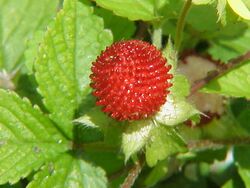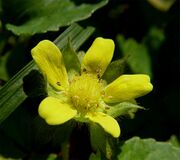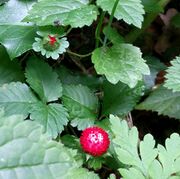Biology:Potentilla indica
| Potentilla indica | |
|---|---|

| |
| Scientific classification | |
| Kingdom: | Plantae |
| Clade: | Tracheophytes |
| Clade: | Angiosperms |
| Clade: | Eudicots |
| Clade: | Rosids |
| Order: | Rosales |
| Family: | Rosaceae |
| Genus: | Potentilla |
| Species: | P. indica
|
| Binomial name | |
| Potentilla indica (Andrews) Th.Wolf
| |
| Synonyms[1] | |
| |
Potentilla indica, known commonly as mock strawberry,[2] Indian-strawberry,[3] or false strawberry,[4] often referred to as a backyard strawberry, mainly in North America, is a flowering plant in the family Rosaceae.[1][5] It has foliage and an aggregate accessory fruit similar to that of a true strawberry. It has yellow flowers, unlike the white or slightly pink flowers of true strawberries. It is native to eastern and southern Asia, but has been introduced to many other areas as a medicinal and an ornamental plant, subsequently naturalizing in many regions worldwide.[1][5][6][2]
Many sources consider this plant part of the genus Potentilla[1][7][3][5][8][9][10][11] due to evidence from chloroplast genetic sequence data that the genus Duchesnea is included within Potentilla,[12] though some still list it as Duchesnea indica.[13]
Description
The leaves are trifoliate, roughly veined beneath, dark green, and often persisting through the winter, arising from short crowns. The plant spreads along creeping stolons, rooting and producing crowns at each node. The yellow flowers are produced in mid spring, then sporadically throughout the growing season. The aggregate accessory fruits are white or red, and entirely covered with red achenes, simple ovaries, each containing a single seed.[14][15]
Uses
The fresh berries are edible but considered less palatable than proper strawberries.[16][17]
References
- ↑ 1.0 1.1 1.2 1.3 "Potentilla indica (Andrews) Th.Wolf". Royal Botanic Gardens, Kew. https://powo.science.kew.org/taxon/urn:lsid:ipni.org:names:728289-1. Retrieved 1 May 2020.
- ↑ 2.0 2.1 Missouri department of Conservation. "Indian Strawberry (Mock Strawberry)". http://mdc.mo.gov/discover-nature/field-guide/indian-strawberry-mock-strawberry. Retrieved 22 November 2013.
- ↑ 3.0 3.1 "Potentilla indica", Go Botany (New England Wildflower Society), https://gobotany.nativeplanttrust.org/species/Potentilla/indica/, retrieved 1 May 2020
- ↑ O’Brien, Meghan (December 2006). "Indian Strawberry". http://www.bellarmine.edu/faculty/drobinson/IndianStrawberry.asp. Retrieved 2017-06-13.
- ↑ 5.0 5.1 5.2 "Potentilla indica", County-level distribution map from the North American Plant Atlas (NAPA) (Biota of North America Program (BONAP)), 2014, http://bonap.net/MapGallery/County/Potentilla%20indica.png
- ↑ "Invasive species in Belgium: Duchesnea indica". http://ias.biodiversity.be/species/show/107. Retrieved 22 November 2013.
- ↑ "Potentilla indica". Database of Vascular Plants of Canada (VASCAN). 2010. https://data.canadensys.net/vascan/taxon/20038. Retrieved 1 May 2020.
- ↑ Weakley, Alan S. (2018), Flora of the Southern and Mid-Atlantic States, working draft of 20 August 2018, University of North Carolina Herbarium, North Carolina Botanical Garden, University of North Carolina at Chapel Hill
- ↑ Reznicek, A. A.; Voss, E. G.; Walters, B. S., eds (February 2011). "Potentilla indica". University of Michigan Herbarium. https://michiganflora.net/species.aspx?id=2478.
- ↑ "Taxonomy - GRIN-Global Web v 1.10.6.2". https://npgsweb.ars-grin.gov/gringlobal/taxonomydetail.aspx?id=29500. Retrieved 8 May 2020.
- ↑ Mabberley, D. J. (2002). "Potentilla and Fragaria (Rosaceae) reunited". Telopea 9 (4): 793–801. doi:10.7751/TELOPEA20024018. http://plantnet.rbgsyd.nsw.gov.au/Telopea/results.php?Where=ArtParentRef=%273%27+and+ArtVolume=%279%27+and+ArtIssue=%274%27. wikidata:Q55801498.
- ↑ Torsten Eriksson; Malin S. Hibbs; Anne D. Yoder; Charles F. Delwiche; Michael J. Donoghue (2003). "The Phylogeny of Rosoideae (Rosaceae) Based on Sequences of the Internal Transcribed Spacers (ITS) of Nuclear Ribosomal DNA and the trnL/F Region of Chloroplast DNA". Int. J. Plant Sci. 164 (2): 197–211. doi:10.1086/346163.
- ↑ "World Flora Online: Duchesnea Sm.". World Flora Online Consortium. 2020. http://www.worldfloraonline.org/taxon/wfo-4000012695.
- ↑ Ertter, Barbara (2012). "Duchesnea indica var. indica". https://ucjeps.berkeley.edu/eflora/eflora_display.php?tid=91747. Retrieved 2 May 2020.
- ↑ University of Missouri: Division of Plant Sciences
- ↑ (in en-US) The Complete Guide to Edible Wild Plants. United States Department of the Army. New York: Skyhorse Publishing. 2009. pp. 52. ISBN 978-1-60239-692-0. OCLC 277203364. https://www.worldcat.org/oclc/277203364.
- ↑ "Are the mock strawberries toxic?". 1986. https://www.cfsanappsexternal.fda.gov/scripts/plantox/detail.cfm?id=13794.
Wikidata ☰ {{{from}}} entry
 |






